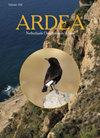同种密度对丹麦三个鸬鹚种群后代身体状况的影响
IF 1.3
4区 生物学
Q3 ORNITHOLOGY
引用次数: 0
摘要
在繁殖季节,猎物的密度依赖性耗竭可能影响海鸟和殖民地水鸟的繁殖性能和群体发育。大鸬鹚是中心觅食者,因此父母飞往有利可图的觅食地的飞行距离以及父母为后代提供的食物可能受到当地食物供应的影响。因此,一个特定种群的雏鸟身体状况可能受到与喂食区域的距离、鱼类种群和鱼类分布的变化以及邻近种群使用同一喂食区域的鸬鹚数量的影响。在vorsoø (VO)、mamageø erne (MA)和Stavns Fjord (SF)三个觅食范围重叠且进入浅海区域的丹麦大鸬鹚群落中,研究了1993-2007年期间雏鸟平均身体状况(n = 9697)与种群位置、年份、种群大小和觅食同种个体估计密度的关系。VO群体父母的觅食区域具有最高的理论同种密度,并且VO雏鸟的状况总是比其他两个群体的雏鸟差。雏鸡体况与估计的觅食密度呈负相关,特别是在20 km的觅食范围内。这三个种群之间的身体状况多年来呈弱相关,这表明宏观环境条件(如鱼类密度)的变化对食物供应的影响不大,与鸬鹚数量无关。我们得出结论,群落的地理位置、群落本身和最近邻近群落的大小以及相关的觅食密度变化是不同种群和年份间雏鸟身体状况变化的主要驱动因素。本文章由计算机程序翻译,如有差异,请以英文原文为准。
Conspecific Density as a Driver of Offspring Body Condition in Three Cormorant Colonies in Denmark
Density-dependent depletion of prey during the breeding season may affect breeding performance and colony development in seabirds and colonial waterbirds. Breeding Great Cormorants Phalacrocorax carbo sinensis are central place foragers, so parental flight distances to profitable foraging grounds and thus parental provisioning of offspring are likely affected by local food availability. Chick body condition in a given colony may therefore be influenced by the distance to feeding areas, changes in fish stocks and fish distribution as well as the number of Cormorants from neighbouring colonies using the same feeding areas. At three Danish Great Cormorant colonies with overlapping foraging ranges and variable access to shallow marine areas, Vorsø (VO), Mågeøerne (MA) and Stavns Fjord (SF), we investigated variation in mean chick body condition (n = 9697) in relation to colony location, year, colony size and estimated density of foraging conspecifics during 1993–2007. Foraging areas available to VO colony parents had the highest theoretical densities of conspecifics and the VO chicks were invariably in poorer condition than the chicks at the other two colonies. Chick body condition was negatively correlated with estimated foraging density, especially within a foraging range of 20 km. Body condition between all three colonies was weakly correlated over the years, suggesting that changes in macro-environmental conditions (e.g. fish density) only had moderate impacts on food availability, independently of Cormorant numbers. We conclude that both the geographical location of colonies, the size of the colony itself and the nearest neighbouring colonies and the associated variation in density of foraging Cormorants were major drivers of variation in chick body condition between colonies and years.
求助全文
通过发布文献求助,成功后即可免费获取论文全文。
去求助
来源期刊

Ardea
生物-鸟类学
CiteScore
2.10
自引率
0.00%
发文量
49
审稿时长
>12 weeks
期刊介绍:
Ardea is the scientific journal of the Netherlands Ornithologists'' Union, and is published since 1912. The journal welcomes manuscripts reporting significant new findings in ornithology, in particular those covering the ecology, life history, and evolution of birds, and including sound descriptive work. Ardea publishes Original research papers, Short notes and Book reviews. In addition to the regular three issues per year, Ardea publishes specials that contain conference or workshop proceedings (produced on request).
 求助内容:
求助内容: 应助结果提醒方式:
应助结果提醒方式:


